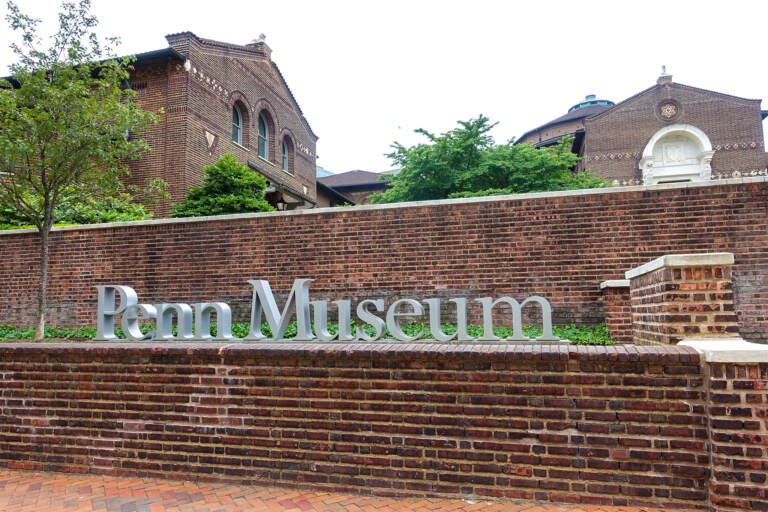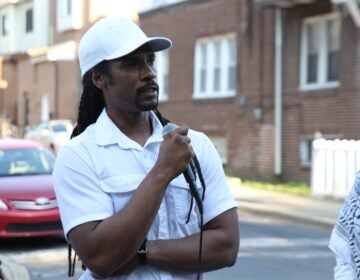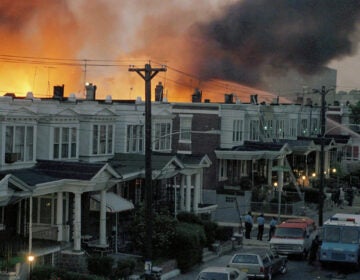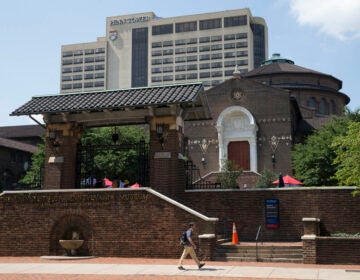Penn Museum has laid to rest 19 skulls from its Morton Cranial Collection
This historic collection of 19th century skulls — acquired by unethical means for racist research — is beginning to be laid to rest, over protests.
Listen 1:40
Penn Museum in West Philadelphia. (Wikimedia Commons/Gordon Makryllos)
From Philly and the Pa. suburbs to South Jersey and Delaware, what would you like WHYY News to cover? Let us know!
On Saturday, the Penn Museum will host a public memorial ceremony honoring the unidentified remains of Black Philadelphians whose skulls were collected in the 19th century as part of the Morton Cranial Collection.
These are the first remains to be laid to rest from the museum’s controversial Morton Collection, a move that has attracted criticism from activists and scientists.
The museum has determined that of the more than 900 skulls in the collection, 20 originated from Philadelphia and were likely obtained by methods now viewed as unethical. Nineteen have already been interred in mausolea at Eden Cemetery, a historically Black cemetery in West Philadelphia.
The 20th remains are those of John Vorhees, a man determined to have descended from Native American lineage. Vorhees’ remains have been removed from the rest of the collected remains and will be repatriated per the Native American Graves and Repatriation Act (NAGPRA).
Penn Museum director Christopher Woods said there were community witnesses present during last week’s internment at Eden Cemetery, conducted with assistance from West Philadelphia’s Terry Funeral Home, but it would have been too logistically complicated to invite the general public to watch.
“We were not certain exactly how things would fit, and even opening and closing the monument proved to be a challenge,” Woods said. “It was something that we needed to be fully focused on.”
The commemoration ceremony will take place this weekend at Penn Museum on the campus of the University of Pennsylvania, followed by a blessing at the cemetery. The gathering will feature an interfaith lineup of speakers and University representatives, and musical performances will solemnify the occasion. The public is invited to attend both the ceremony and the blessing afterward at the cemetery. Pre-registration online is encouraged.
The Black Philadelphians Descendant Community Group insists Penn Museum is doing it wrong. A leader of the group of self-determined descendants, aAliy Muhammad, is opposed to the burial, the ceremony, and the process by which the museum is laying the remains to rest.
Muhammad, a member of the museum’s community advisory committee, has for years led efforts to force the museum to acknowledge and address its past historical practices. They assert that descendant community should determine the respectful reinterment of the remains, not the museum who benefited from their possession.
“I’m a part of a group of Black Philadelphians who deeply disagree with how Penn is trying to exert power and control over the process of return,” they said.
The internment and ceremony are the latest steps in a process that began in 2020 when activists, including Muhammad, demanded Penn Museum rectify a dark chapter of its history. The collection of skulls was mostly assembled by Dr. Samual Morton, an early 19th century scientist who measured skulls to determine racial differences, toward establishing evidence of white superiority.
Morton’s work is now understood to be deeply racist and invalid, but the skulls continued to be used for other kinds of anthropological study. Some skulls in the collection were stored on open shelves in classrooms.
In 2021 the museum publicly apologized for accepting the collection in 1966 and then formally accessioning it into its archive in 1996. The museum began a process to figure out where and how to respectfully lay the skulls to rest, including researching the identities of the remains and assembling a community advisory committee to oversee their burial and repatriation.
Woods said little is known about the remains, including the identities and descendants of the deceased.
“When Morton collected the crania of these individuals, for these 19, he didn’t record a name. That wasn’t something he was interested in,” Woods said. “The information we have is primarily limited to age range, sex, occasionally circumstances of death, and of course race. It may be possible in the future to uncover some names, but given the nature of these records I’m doubtful that we’ll ever be able to retrieve the names of all of them.”
The Black Philadelphians Descendant Community Group partnered with historians and anthropologists to form a larger entity, Finding Ceremony, which is conducting its own independent research into the remains. It was Finding Ceremony that determined one of the decedents, John Vorhees, was Native American, thus his remains fall under the purview of NAGPRA.
Last year Muhammad sued to block the museum’s plan to bury the remains, but a judge determined the descendent group did not have legal standing to be heard in court.
Even though the group could not gain legal recognition, Lyra Monteiro, an anthropologist at Rutgers University and a co-convener of Finding Ceremony, said the group should nevertheless have a hand in how the remains are put to rest. She points to the African Burial Ground National Monument in Manhattan, the result of a process that began in the 1990s when the city opted to consult with a self-determined descendant community to conceive and build a permanent memorial over a recently discovered Black cemetery.
Monteiro claims Penn Museum failed to perform adequate research, relying primarily on records kept by Morton and others who researched the collection, instead of utilizing outside historical records.
Most of the Philadelphia remains were acquired from people who had died in a West Philadelphia almshouse, a poorhouse which kept its own internal records of tenants. That is how the Native American background of John Vorhees was discovered.
“Folks who were in institutions like almshouses — as most of these people seem to have been when they died — were relentlessly recorded. There are details about their life that nobody should know, because they were constantly recorded,” Monteiro said. “For them to say that little can be known — all that means is that they haven’t bothered.”
The process by which museums must repatriate Native American remains was established in 1990 by NAGPRA and involves the participation and permission of federally recognized tribes. For the remains of Black Americans there is no such standard. Sovereign nations, such as Native American tribes, have federally recognized governance structures that allow them to make autonomous decisions on behalf of tribes and tribal members. In contrast, Black Americans have no similar centralized authority or federally recognized entity to represent them collectively on the national level.
Penn Museum is trying to establish a set of best practices to appropriately honor and repatriate Black remains, which could be adopted across the museum industry. Finding Ceremony is also trying to determine best practices, but firmly insists those practices be based on the will of descendant communities, not the museums which have often failed to regard remains and artifacts with proper reverence and respect.
Monteiro said if Finding Ceremony could find new background information on one set of remains, it’s likely they can find more. The team of nearly two dozen volunteer researchers have started researching the identities of five other sets of remains. She is confident they will turn something up.
Pastor Wendell Mapson of Monumental Baptist Church in West Philadelphia was part of the museum’s community advisory committee. He will speak at the commemoration ceremony on Saturday, and plans to acknowledge those dissenting positions.
“I understand the sense of outrage and the desire for accountability,” Mapson said. “But at the same time, let’s not hold the remains hostage to our racial or political objections, when we could still work on: How does Penn respond going forward?”
Woods does not describe the internment at Eden Cemetery a form of repatriation, as the remains have not been wholly given to the stewardship of another entity. Rather, he said the remains are held in a collaborative stewardship with the community. Because of the way they were laid to rest — they are not buried in the ground but sealed in coffin urns in above-ground mausolea — should new information about their identities be discovered in the future there will be an opportunity to inter the remains in a more appropriate place.
Woods does not want to fall into a perpetual holding pattern of waiting for more research that may never come.
“This is something that museums and institutions do too often: They’re not going to make a transfer or repatriation, or engage in a type of shared stewardship that we’re doing, because, ‘Well, we need more research to be done.’ In the end that’s tantamount to doing nothing,” he said. “I predict — I hope I’m wrong here — but for most of these individuals I’ll be surprised if an identification can be made.”
Woods said research has begun on other remains in the Morton collection. He said the next ancestral skulls to be prepared for repatriation will likely be from Cuba, where Morton used the remains of people who had been enslaved.

Get daily updates from WHYY News!
WHYY is your source for fact-based, in-depth journalism and information. As a nonprofit organization, we rely on financial support from readers like you. Please give today.







